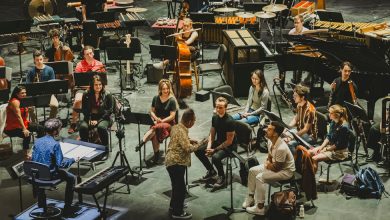5 Minutes That Will Make You Love Bach

In the past we’ve chosen the five minutes or so we would play to make our friends fall in love with classical music, piano, opera, cello, Mozart, 21st-century composers, violin, Baroque music, sopranos, Beethoven, flute, string quartets, tenors, Brahms, choral music, percussion, symphonies, Stravinsky, trumpet and Maria Callas.
Now we want to convince those curious friends to love the stirring, consoling music of Johann Sebastian Bach, the grand master of the Western classical tradition. We hope you find lots here to discover and enjoy; leave your favorites in the comments.
◆ ◆ ◆
Dan Tepfer, pianist and composer
People occasionally say that Bach is too mathematical or intellectual, which of course is an opinion I don’t share. To me, his music lives at the intersection of the algorithmic and the spiritual, his logical structures working together with his humanity and emotional sensitivity. When I need to remind anyone of this, this is the track I turn to. Lorraine Hunt Lieberson delivers a cantata about the acceptance of death with profound grace, in a dialogue with the oboist Peggy Pearson. It’s gorgeous, moving and, thanks to the deep structure underneath, timeless.
“Ich habe genug”
Lorraine Hunt Lieberson; Orchestra of Emmanuel Music; Craig Smith (Nonesuch)
◆ ◆ ◆
Michael Marissen, musicologist
The closing movement of Bach’s “Ascension Oratorio” ingeniously combines two musical moods whose interplay reveals a profound truth about this composer’s spiritual outlook. The choir’s soprano line intones a melancholy hymn tune in B Minor, the text yearning for a better future. The orchestra, however, furnishes a rollicking backdrop — mostly in D Major — with swirling sequences of exuberant syncopation. Joy overwhelmingly triumphs, no question about that. Yet sad longing is not totally eclipsed.
“Ascension Oratorio”
“Wenn soll es doch geschehen”; Bach Collegium Japan; Masaaki Suzuki (Bis)
◆ ◆ ◆
Javier C. Hernández, Times classical music and dance reporter
Bach’s six cello suites are not just intimate explorations of that instrument, but also profound meditations on existence and aspiration. When he set out to write these pieces, around 1720, he had few models; the cello was still a relatively new instrument, largely relegated to background roles in ensembles. In this recording of the third suite by Anner Bylsma, who championed period instruments, Bach’s sense of adventure and discovery radiates from each phrase.
Cello Suite in C
Anner Bylsma, cello (Sony)
◆ ◆ ◆
John Eliot Gardiner, conductor
If I was forced to choose just one work of Bach’s to prove he was the greatest of all composers of religious music, it would be the “Actus Tragicus” (Cantata 106), written when he was only 22.
What makes it so special? It was written for a funeral, but we don’t know whose. And like so many of his works on the subject of death, it’s serene and basically optimistic — never morbid or saccharine. Bach himself knew a thing or two about death; having lost both his parents before his 10th birthday, he was forced to dig deep and become self-reliant. This music is not just extraordinarily beautiful — it’s consoling. Ask anyone in need of solace when coping with grief: It doesn’t matter if they’re Christian, agnostic or atheist, if they’ve somehow been directed to the “Actus Tragicus”they find inspiration and comfort.
“Actus Tragicus”
“Gottes Zeit ist die allerbeste Zeit”; Monteverdi Choir; English Baroque Soloists; John Eliot Gardiner (Deutsche Grammophon)
◆ ◆ ◆
Daniil Trifonov, pianist
The Russian composer Rimsky-Korsakov called Bach “a benevolent god to which all musicians should offer a prayer to defend themselves against mediocrity.” There is a long history of Bach’s music being admired in Russia — by composers from Rimsky-Korsakov to Schnittke, and by prominent performers, whether in the historically informed performance tradition or on modern instruments.
One of the greatest Bach interpreters was Samuel Feinberg, who recorded one of my favorite renditions of “The Well-Tempered Clavier”; this particular transcription is striking for how incredible it makes the modern piano sound in the service of the music. This recording is a perfect example of the way the spirit of music expresses itself first and foremost through the heart and mind of the interpreter, transcending instrumental boundaries.
Organ Sonata in C
Largo transcribed and played by Samuel Feinberg (Classical Records)
◆ ◆ ◆
Zachary Woolfe, Times classical music editor
When we say that Bach is consoling, we usually mean he is slow, mellow, tender. But this is the Bach to which I turn to be lifted: the jamboree finale of his Third “Brandenburg” Concerto. For many, the “Brandenburgs” are staid holiday-season stalwarts, but the Akademie für Alte Musik Berlin brings them ferociously, ecstatically to life. Especially here, as chaos deepens, turning almost unbearably intense, before a single violin soars out, fiddling away at the most heartbreaking, heart-making dance.
“Brandenburg” Concerto No. 3
Akademie für Alte Musik Berlin (Harmonia Mundi)
◆ ◆ ◆
Roderick Williams, singer
Even without its context, this is a most beautiful aria. The two violas d’amore twist an exquisite melody above a patient bass line, while a lute or harpsichord tinkers quietly in the middle of the textures. And then the bass soloist traces a sinuous line across the top. But the context is astonishing: “Betrachte, meine Seel” comes in the Passion story just after Christ has been flagellated. The brutality of the moment contrasts with this music of such beauty. I think that says a lot about Bach’s faith. And I love singing it.
“St. John Passion”
Cornelius Hauptmann; English Baroque Soloists; John Eliot Gardiner (Deutsche Grammophon)
◆ ◆ ◆
Hilary Hahn, violinist
I grew up with Bach’s sonatas and partitas for violin, played on four strings with one bow, but the organ is one of my favorite instruments. Its range of timbres and dynamics is huge, and it’s played with hands and feet. Its notes sustain forever. Organ can whistle coyly one minute, rattle your bones the next.
As the dominant instrument of Bach’s career, it demonstrates the dramatic scope of his compositional identity. The audacity of his organ music blows my mind. Bach was not a polite composer. He built cathedrals of music. In this fugue — one of his trademark compositional forms — you hear his musical soul: fearless, passionate, humorous and deeply compassionate.
Fugue in D Minor
Simon Preston, organ (Deutsche Grammophon)
◆ ◆ ◆
Vijay Iyer, composer and pianist
Bach’s solo works — for keyboard, cello, violin — offer endless room for interpretation and reinvention. When I first encountered Aisha Orazbayeva’s haunting, gossamer version of the Allemande and Double from the B Minor Partita, I heard her two-violin arrangement as a surreal, heterophonic micro-decoration of the Allemande.
As it ended, I wondered what had happened to the Double, the variation that normally follows and was announced in the title. Finally I realized that it was there all along — simultaneous with the Allemande. Orazbayeva’s elemental compositional gesture, a simple overlay of Bach with and against himself, yields a rich, mysterious counterpoint, with moments of eerie conjuncture.
Violin Partita in B Minor
Arranged and performed by Aisha Orazbayeva
◆ ◆ ◆
Midori, violinist
Some years back, after I performed this piece at an elementary school, one of the kids commented that this “song moves my heart.” I completely agree and am still in awe of how simply and perfectly this timeless classic could be described by a 9-year-old. The Partita No. 3’s Preludio presents us with a “perpetuum mobile” from beginning to end, the music constantly ascending and descending, its emotional footprint one of remarkable freshness, of wonder and flow.
In such virtuosic music, structure and spirit mesh perfectly — at times creating a sense of hopeful expectancy, at other times fulfilling it. This is music I love playing on violin, but I also appreciate listening to how it comes to life when performed on lute, which lends a special piquancy in keeping with Bach’s lively ardor.
Violin Partita in E
Hopkinson Smith, lute (Naïve)
◆ ◆ ◆
Jolle Greenleaf, singer and Tenet artistic director
There’s always a message with Bach. He knows how to take text and perfectly marry it to music. This aria brings tears to my eyes every time I hear it. It feels like a warm, comforting hug in the midst of unimaginable grief. The violins and oboe da caccia play in unison, their sound the very essence of bittersweetness. The singer’s melody is so open and welcoming; it pulls at my heartstrings and reminds me why I chose to spend my life in service to music.
“St. Matthew Passion”
“Mache dich, mein Herze, rein”; Sumner Thompson; Tenet Vocal Artists and the Sebastians
◆ ◆ ◆
David Allen, Times writer
Bach wrote no grander fugue than this one in E flat, published in 1739 and the conclusion of his third “Clavier-Übung,” which is sometimes known as the “German Organ Mass.” A towering triple fugue, for many it has appeared to invoke the Holy Trinity.
Its first section builds from a steady, solemn invocation of a tune that more than resembles the hymn “O God, Our Help in Ages Past.” In the second section, the first, paternal theme is barely hinted at amid busily running eighth notes — “as if to suggest the divine assumption of an earthly form,” as the organist Albert Schweitzer put it. The final section finds sixteenth notes rushing through, a spirit on the wind. It is composing of immense virtuosity, and it demands the same from an organist, but it is virtuosity in the service of devotion — as Bach’s always was.
Fugue in E flat
Karl Richter, organ (Deutsche Grammophon)
◆ ◆ ◆
Anthony Tommasini, Times chief classical music critic
Bach’s Keyboard Partita in E Minor, a seven-movement suite teeming with dark, spiky, rhapsodic music, ends with a stunningly intense and complex Gigue. You sense just a tenuous connection here with the gigue as it was known in England and Italy, as a lively dance.
The theme, played at first in one voice, establishes the character that runs through this formidable fugal movement, with a constant short-long rhythmic riff that keeps taking skittish leaps. Though the contrapuntal elaborations that unfold are awesomely complex, the sheer daring and severity of the music keep you riveted. With its angular lines and bold harmonic discursions, the Gigue almost sounds like Bach was anticipating pointillist atonality — qualities captured in Igor Levit’s fearsome playing.
Keyboard Partita in E Minor
Igor Levit, piano (Sony)
◆ ◆ ◆
John Harbison, composer
Today my favorite music in the world is the group of youthful Bach cantatas, among them 161, 163 and 165 — composed in Weimar, about one a month, chamber musical pieces of special directness, intimacy and ecstatic expression. Often the texts, when composed by the Weimar court poet Salomo Franck, are also beautiful: “Holy Spirit, and Wash of Water” — we hear the water throughout — “Flood that inscribes us in the Book of Life.”
Bach later goes on to write more ambitious, more daring cantatas. But no composer can take everything along. My favorite place for performances of his cantatas is the Sunday services (summer excepted) at Emmanuel Church in Boston — visitors to the city welcome!
“O heiliges Geist”
Aki Yanagisawa; Bach Collegium Japan; Masaaki Suzuki (Bis)
◆ ◆ ◆
Seth Colter Walls, Times writer
Bach’s “English” and “French” suites for keyboard were only published posthumously, but we should be glad they were. Pianists as different as Glenn Gould and Angela Hewitt have given winning accounts of these sets.
In her liner notes for the “English” pieces, Hewitt observed that, at the opening of the Third Suite, a swinging quality is appropriate. Which means it’s time to lend an ear to the pianist Friedrich Gulda. In addition to his performances of classical repertoire, Gulda also maintained a sideline in jazz. But he didn’t fully separate the genres. So while handling the fugal writing of this suite’s closing Gigue, he also provides an intoxicating, swaying energy. Too subtle to be a parlor trick, it’s truly a persuasive modern interpretation.
“English” Suite in G Minor
Friedrich Gulda, piano (Deutsche Grammophon)
◆ ◆ ◆
Joshua Barone, Times editor
Once, after a late-night recital focused on late works by Schubert and Beethoven, the pianist Lars Vogt returned to his instrument and paused. What encore could possibly follow? But then he turned to the audience and said that sometimes, all you need is the Aria from Bach’s “Goldberg” Variations.
Its bass line is all Bach needed to spin out 30 variations of the mathematical sublime; the score, with few indications of dynamics or tempos, is all that countless musicians have needed to produce distinct and ever-fresh interpretations. While the Aria’s 32 measures of lyrical serenity and gentle counterpoint are all that’s needed to begin the “Goldbergs,” they are also all that’s needed to end it — or, as Vogt demonstrated that night, any musical journey.
“Goldberg” Variations
Lars Vogt, piano (Ondine)
◆ ◆ ◆




